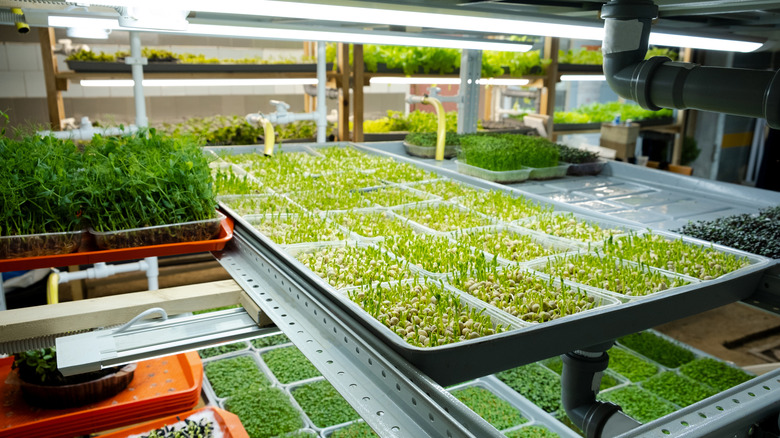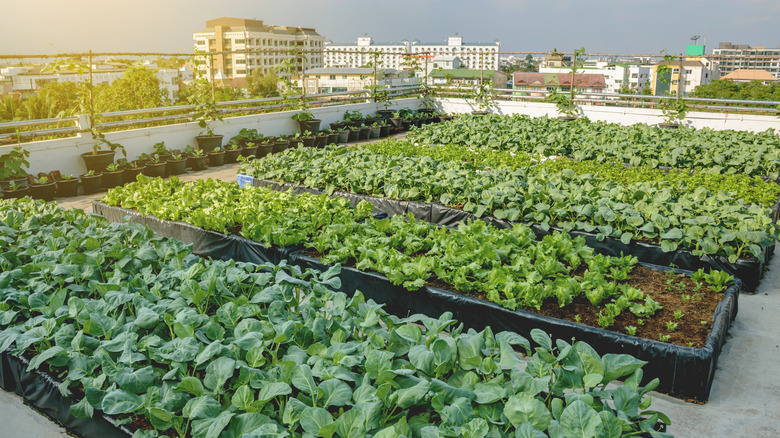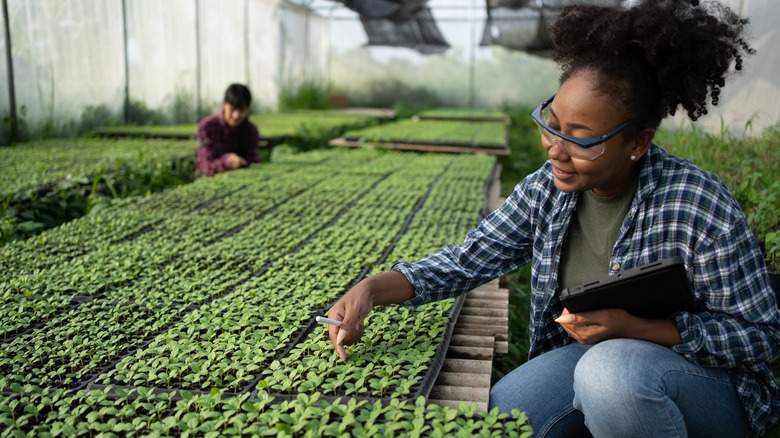New Study Reveals How Crucial Urban Farming Is To Food Security
Fifty-six percent of the world's population lives in cities, according to the World Bank, with that figure expected to grow to nearly 70% by 2050. As the world becomes increasingly urbanized while rural areas depopulate (via University of New Hampshire), leaving some of us to wonder: Where the heck are we going to grow the world's food supply if nobody is living in (and working) our farmlands?
When most of us think of farming, we tend to picture wide-open fields of swaying wheat, or neat rows of tomatoes and lettuce unfurling under blue skies. But increasingly, given the urbanization of society and the shrinking of rural farmland (via Giving Compass), an increasing number of brands are growing crops in cities using urban farming practices, such as Freight Farms' "Leafy Green Machine," a ready-made hydroponic farm inside a 40-foot-by-8-foot-by-9.5-foot shipping container, and the New Jersey-based AeroFarms, a vertical farming company that uses LED lights and aeroponics instead of soil and sunshine (via GreenBiz).
Findings show that urban farming can be highly productive
You've probably heard of — or even bought produce from — any number of urban farming initiatives. But how productive are these companies, really, and do they have the capacity to produce food at the scale of traditional agriculture? A new study published yesterday by researchers at the UK's Lancaster University has concluded that in many cases, the answer is yes.
Published in the journal Earth's Future, the new research indicates that urban gardening techniques including indoor vertical farming and hydroponics meet and in some cases exceed the yields produced by traditional farming in rural areas (via ScienceDaily). Given the boom in urban populations and lingering questions about how those populations will feed themselves in an increasingly urbanized future, researchers out of the UK's Lancaster University wanted to tackle the topic by examining how well cities are equipped to grow crops.
To do so, the team, led by environmental scientist Florian Payen, analyzed the outputs of both urban green spaces such as community gardens as well as "gray spaces," areas such as building rooftops and facades that aren't yet used for growing food but easily could be. The researchers found that some crops, such as cucumbers, root vegetables, and lettuces, yield two to four times the amounts grown rurally when grown in urban settings, with many other urban crops producing similar yields to rurally grown ones.
The study's results could have important implications for urban farming setups
In the case of hydroponics (an indoor growing method that utilizes grow lamps and nutrients dissolved into water to nourish plants instead of sun and soil, according to Miracle-Gro) and vertical farming (an indoor growing system where trays of crops are literally stacked in order to maximize growing space, according to Science Focus), for example, yields can be higher because there's no set growing season determined by weather, with the conditions being simulated by technology, instead.
The findings come as welcome news as society continues to urbanize. Currently, according to ScienceDaily, between 5% and 10% of legumes, vegetables, and tubers are grown in cities, with between 15% and 20% of the global food supply overall raised in urban settings. Erica Dorr, an environmental scientist at AgroParisTech, told ScienceDaily that this proof of the potential to scale up these numbers to feed a growing urban population is "exactly what we have been waiting for in the urban agriculture research community."
That seems like good news for everybody, city slickers and country folk alike.


